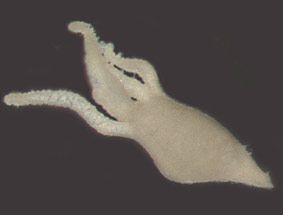| This group is represented in Australia by a single order.
|
| Descriptive Features: a range of body forms
body a simple sack with a ‘mouth’ opening
tentacles with stinging nematocysts
Total length: up to 15 mm, diameter up to 25 mm
|

|
|
| |
| Taxonomic Checklist: Families
Oceaniidae (formerly Clavidae)
Hydridae
Olindiidae
|

|
|
| |
Distribution: Australia wide
Sensitivity Rating: SIGNAL grade 1. Some species can tolerate moderately saline waters.
Functional Feeding Group: predators
|

|
|
| Ecology: Cnidaria occur in lotic and lentic waters including ponds, streams and lakes. Hydridae (hydra) are found as solitary, sessile forms. Clavidae (hyroids) are found as colonial, sessile forms. Olindiidae (jellyfish) are found as free floating solitary forms. Sessile forms live attached to stones and various submerged vegetable detritus. Hydras are often seen in large congregations. They are capable of limited movement in a gliding action. Cnidarians are predators upon zooplankton. Tentacles located around the mouth contain stinging nematocysts that harpoon cladocerans and copepods from the surrounding water. There are asexual (polyp) and sexual (medusa) forms. The polyp dominates the life cycle of Hydridae and Clavidae. The life cycle of Olindiidae is dominated by the medusa.
|
|
| |
| Information Sources: Williams 1980, Gooderham & Tsyrlin 2002, Hawking & Smith 1997
|
More ››› key to families 
|
|